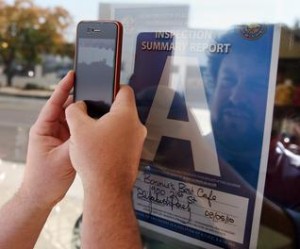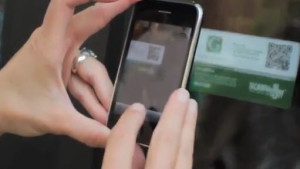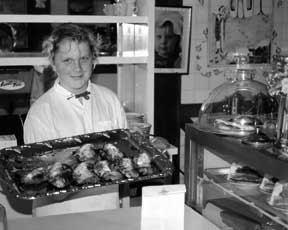Chapman says QR barcodes are so … 2010.
I wanted to do the equivalent using a url so people could find out what went into a product back in 2000.
 Because some producers and companies are better at this food safety thing, and, as a consumer, I’d want to know that.
Because some producers and companies are better at this food safety thing, and, as a consumer, I’d want to know that.
I can’t at retail.
But the technology is catching up to the idea, and in the past week, the Pasadena Department of Public Health announced that it will launch a new restaurant grade database and implement new restaurant rating placards including a QR barcode so diners can scan it with their smartphone and see more information about the restaurant’s inspection on the department’s new restaurant database.
The new restaurant inspection placards will display whether the restaurant passed, failed or passed conditionally, and will also display the numerical score out of 100 that the restaurant received.
Rather than using the letter grade system that the rest of Los Angeles County restaurants use, Pasadena has long used a numerical grading system. Previously, the scores were available online with a pass/fail notice in the window, however, this is the first time the numerical grade would be displayed in the window of a restaurant.
Retailer Longo’s in Ontario has partnered with VG Farms to provide local beef to all Longo’s and Market stores.
This will complete Longo’s offering of Ontario-raised meat, which up until this point included chicken, turkey, pork, lamb and veal. Rosanne Longo, brand ambassador for Longo’s, said the Toronto-area grocery chain searched long and hard to find the right beef farm to work with.
VG Farms is owned by the Van Groningen family. Up until now, VG Farms’ beef was only available at two family stores in Stoney Creek and Simcoe, Ont., in addition to small stores. This will be the first time the farm’s beef will be widely available.
“We’ve expanded our business because we identified that in the Ontario market there was nobody offering a true or authentic farm-to-fork program,” said Cory Van Groningen, owner and the eldest of the four brothers running the farm. “The program we’ve initiated with Longo’s is based on a lot of the best practices we’ve developed over the years.”
VG Farms uses a scientific method to measure the physical tenderness level of the beef, and each package features a QR code to allow shoppers to trace the Ontario farm where the cattle originated, its age and diet.
To familiarize themselves with the product, Van Groningen said 45 meat experts along with senior executives from Longo’s came out to VG Farms to take a tour and try the product for themselves.
Now include that food safety info. The technology is there.
 Article 45 of the newly enacted French Law on the future of agriculture, food and forestry specifies that the results of official controls shall be made public in accordance with modalities which will be laid down by specific regulations, this is the transparency initiative.
Article 45 of the newly enacted French Law on the future of agriculture, food and forestry specifies that the results of official controls shall be made public in accordance with modalities which will be laid down by specific regulations, this is the transparency initiative.





